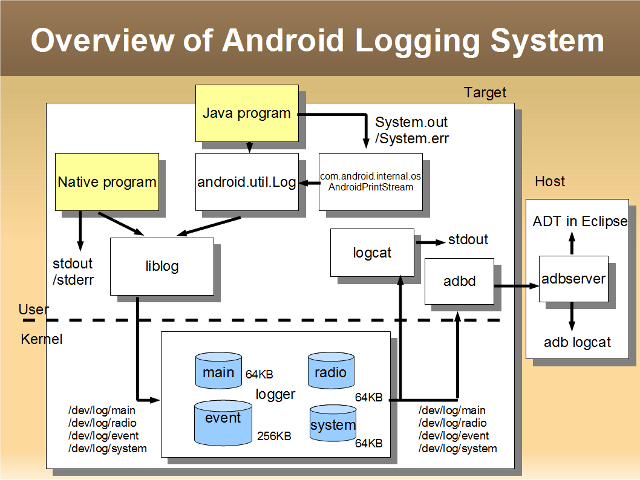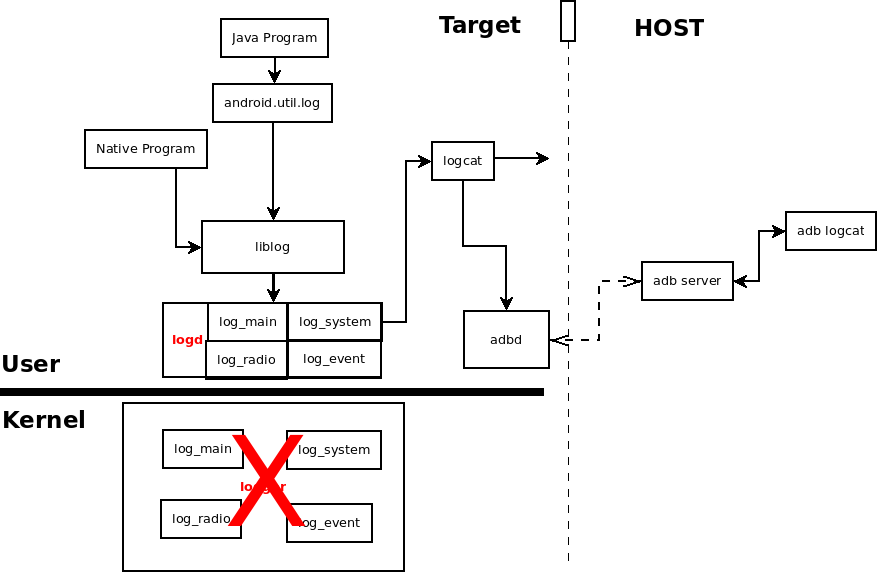Android Logging System
概览
Android系统中构建了一个自己的日志系统,允许从普通应用到系统组件,native应用等来记录日志。这个
日志系统和Linux内核自己的日志系统是不一样的,后者通过dmesg或者/proc/kmsg,/dev/kmsg等访问。
不过这个日志系统也是存储在内核空间的buffer中

日志系统包括下面几个组件:
内核驱动logger,其中申请的buffer来保存日志信息
C,C++,Java类等帮助记录日志信息的工具类
,例如liblog.so
一个单独的程序来查阅日志:logcat
logger驱动申请了四个不同的buffer来分别保存不同的日志信息,可以通过/dev/log/下的节点来访问这些buffer
main - the main application log
events - for system event information
radio - for radio and phone-related information
system - a log for low-level system messages and debugging
日志中的每一条信息都有:一个tag,一个时间戳,日志的重要级别,日志内容。
存储格式:event记录的是二进制信息,这样可以节省空间,但是在读的时候需要额外的处理来解码这些信息;
其他的日志都是直接使用的文本来保存日志内容
日志系统会根据tag来自动将日志路由到不同的buffer中去
kernel driver
android自己写的logger驱动,里面主要是创建了四个misc设备,每个设备有一个ring buffer来管理日志
日志工具类
应用可以通过android.util.log类来记录日志信息,而native的程序可以链接liblog来
记录日志.
其实通过深入android.util.log发现它也是通过JNI->liblog来间接使用liblog记录日志的
最有趣的是提供了一个log命令行工具,它属于toolbox仍然是android自己写的,里面的
东西大概都是仿照busybox来做的,不过功能都是经过阉割的;另外添加了一些自己的工具,
例如netcfg等。在最近的版本中,android重新赞助基于busybox开发,可以参考
CM的busybox提交日志。
USAGE: log [-p priorityChar] [-t tag] message
priorityChar should be one of:
v,d,i,w,e
另外还有一个logwrapper工具,在android启动过程中,我们可能会执行一些shell脚本,
此时可以将shell脚本的执行输出从标准输出重定向到android的日志系统中,之后通过logcat
查看
root@b8g:/dev # logwrapper
Usage: logwrapper [-a] [-d] [-k] BINARY [ARGS ...]
Forks and executes BINARY ARGS, redirecting stdout and stderr to
the Android logging system. Tag is set to BINARY, priority is
always LOG_INFO.
-a: Causes logwrapper to do abbreviated logging.
This logs up to the first 4K and last 4K of the command
being run, and logs the output when the command exits
-d: Causes logwrapper to SIGSEGV when BINARY terminates
fault address is set to the status of wait()
-k: Causes logwrapper to log to the kernel log instead of
the Android system log
logcat
我们一般通过logcat来查看日志信息,或者更熟悉的adb logcat,android eclipse的日志
都是最终通过logcat来查看日志的,具体的参数可以logcat -h
有两种比较常用的:
1.过滤,通过-b来选择日志类别,-v来选择日志的级别和tag
2.清空日志buffer:-c,在开始测试之前清空日志,避免干扰
3.重定向日志到文件,日志本身是保存在内存中的,可以通过重定向到文件中来永久存储日志
Changes
自从4.4 kitkat到5.1 Lollipop,默认不再使用内核的logger驱动来保存日志,而是默认使用logd来管理日志信息;
这是一个进步,没有必要修改内核,同时其他系统也可以移植logd来管理日志,通用性更好
